Coppicing a Cultural Thread
from the Past to the Present
by Dino Labiste
The art of Native California basketry reveals a culture's tradition,
history and the intimate relationship between the weavers, the
environment and the seasonal cycle. The art form speaks of the
care and spirit put directly into the basket by its weaver. The
woven container shows the mind of the maker and the knowledge
of traditional skills to prune, gather, prepare and twine (or
coil) the various plant resources.
Coppicing dates back to a time of Native California hunters
catching steelhead trout with basket fish traps and gatherers
carrying loads of acorns in their burden baskets. Basket weaving
is one of the important cultural threads in the Native California
communities. A thread that carries with it traditions as well
as a respect for the land and its resources. Pruning and fire-setting
were the few land management tools that the native weavers used
to promote the long, flexible willow withes needed to make a shapely
basket.
The elegant combination of functional purpose and aesthetic
beauty can be found in a whole shoot, twined willow basket. A
basket made of willow has its beginning in a process called coppicing
or pruning. Coppicing is a practice of environmental management
used by Native California basket weavers. It involves pruning
a plant back to its base and removing the weak shoots to encourage
vigorous growth. The plant is allowed to regrow from the cut stumps.
Willows are coppiced to stimulate the propagation of long, slender
and flexible branches or shoots. The willow withes are utilized
in the warp elements (lengthwise threads) and weft elements (horizontal
threads) of the basket. Coppicing provides an environmentally
sustainable source of willow withes through periodic cutting,
which actually prolongs the life of the tree. Besides preserving
traditional skills, pruning creates a rich mosaic of habitats,
attracting a diverse range of flora and fauna.
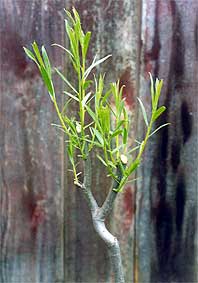 Coppicing is based
on the principles of plant physiology. In order to prune effectively,
a weaver has to know something about how a plant grows. A plant
has three main structures: roots, stem and leaves. The roots main
functions are to absorb water and nutrients, to anchor the plant
in the soil and to store food, which is released when required
by root cells or distributed to above ground parts. The stem supports
other plant parts, such as leaves and flowers. It also transports
materials and stores certain materials. The leaves main function
is photosynthesis. Photosynthesis converts energy from the sun
to chemical energy. It is then synthesized to glucose and other
organic compounds necessary for the plant's nutrition.
Coppicing is based
on the principles of plant physiology. In order to prune effectively,
a weaver has to know something about how a plant grows. A plant
has three main structures: roots, stem and leaves. The roots main
functions are to absorb water and nutrients, to anchor the plant
in the soil and to store food, which is released when required
by root cells or distributed to above ground parts. The stem supports
other plant parts, such as leaves and flowers. It also transports
materials and stores certain materials. The leaves main function
is photosynthesis. Photosynthesis converts energy from the sun
to chemical energy. It is then synthesized to glucose and other
organic compounds necessary for the plant's nutrition.
The stem (also called shoot, trunk, twig, branch or limb) carries
water and nutrients from the roots to the plant's growing points
(buds, leaves and flowers). It also carries food (sugars) that
the leaves make to the roots. Since stems are conveying tubes,
it can be cut off to divert the flow of nutrients to other buds
and branches. By stopping growth in one direction, growth can
be encouraged in other directions.
The willow coppiced in the photos is Hinds willow (Salix
hindsiana). It is also called Grey willow. The narrow leaves
taper at both ends and are covered with gray, silky hairs. Hinds
willow inhabits moist soils of ditches, sandbars and stream banks.
Its range is usually confined to California.
Another species of basketry willow 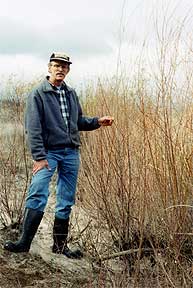 is
Sandbar willow (Salix exigua). This hardy plant has perhaps
the greatest range of all tree willows in the United States. It
is found throughout the interior from the Yukon River in central
Alaska to the Mississippi River in southern Louisiana. The leaves
are very narrow and pointed at the ends. The colors of the leaves
are gray-green on both surfaces. Sandbar willow grows in wet soils,
especially riverbanks, sandbars and silt flats.
is
Sandbar willow (Salix exigua). This hardy plant has perhaps
the greatest range of all tree willows in the United States. It
is found throughout the interior from the Yukon River in central
Alaska to the Mississippi River in southern Louisiana. The leaves
are very narrow and pointed at the ends. The colors of the leaves
are gray-green on both surfaces. Sandbar willow grows in wet soils,
especially riverbanks, sandbars and silt flats.
Not all willow withes are as flexible as Sandbar or Hinds willow.
To test a willow to see if it is suitable for basketry withes,
pick a thin branch or shoot (preferably from one year's growth
and no side branches) and try tying an overhand knot without cracking
it.
Hinds willow thickets in the wild have dense growth with lots
of weak shoots all competing for the light. These dense thickets
have the effect of taking all the light away from the plants and
grasses growing underneath, eventually eliminating them. Most
of the new branches and shoots in the spring become infested with
insect larvae that make them undesirable for baskets. To control
insect infestation and to cultivate the thin, long branches for
basketry withes, a patch of willow is coppiced to provide an indefinite
supply of branches. The willow regenerates itself, without the
need for a continuous cycle of planting. The willow is pruned
back while the plant is in its dormant stage during the winter
season or early spring. This is the time of year when the sap
is low in the plant. Generally, willows that are native to cool
or cold-winter regions are dormant during their leafless period.
The best time to coppice is when it will least shock the plant,
which is when it is not actively growing.
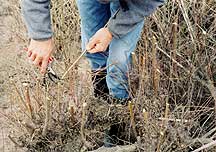 Besides creating rapid
regrowth from the edge of the stumps and removing poor specimens,
coppicing Hinds willow has other benefits to the environment.
It increases the amount of light on the ground allowing some flora
to flourish, which in turn supports more diverse wildlife. Also
any diseased growth is cut away before it can spread throughout
the whole tree. For the best willow withes, the plant is coppiced
severely during its dormant period to promote fast growing, straight
shoots for the following year.
Besides creating rapid
regrowth from the edge of the stumps and removing poor specimens,
coppicing Hinds willow has other benefits to the environment.
It increases the amount of light on the ground allowing some flora
to flourish, which in turn supports more diverse wildlife. Also
any diseased growth is cut away before it can spread throughout
the whole tree. For the best willow withes, the plant is coppiced
severely during its dormant period to promote fast growing, straight
shoots for the following year.
Coppicing willow first involves trimming away the small twigs.
Then medium stems and large trunks are cut about a foot above
ground level. When the stem falls, it does not rip the wood near
the final cutting place. All stumps are then cut two inches above
ground level. The clean, smooth surface cut is angled, with the
top sloping outwards to allow any rainwater to drain away. Successful
coppicing required sharp tools, whether using stone spalls or
modern pruning saws and loppers.
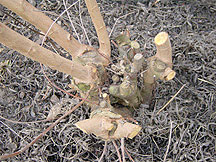
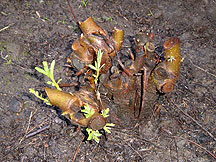
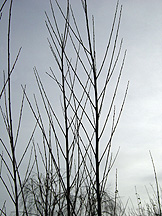
For whole shoot, twined baskets, one year's growth of willow
withes is harvested in late December or January. Gathering is
anytime between the dropping of the leaves and the appearance
of new buds. Tamara Wilder and Steven Edholm mention a few notes
on harvesting willow withes in their article entitled, "Whole-Shoot
Willow Baskets":
"If the shoots are gathered in the dormant season (from
leaf drop to bud swell), the bark will adhere tenaciously. If
they are harvested in early spring (just after bud break), the
bark slips off easily. By mid spring, anything that was not cut
will begin branching out and will become less desirable. We prefer
to harvest during the dormant season and weave with the bark
on. This way the shoots are less prone to cracking and have greater
wear resistance."
Native California basket weavers understood the importance
of gathering during the right time of the year. The shoots have
a lot of water when the willow is growing, which causes them to
shrink more when drying.
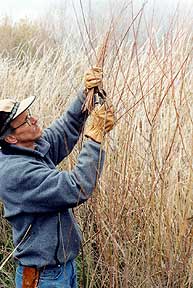
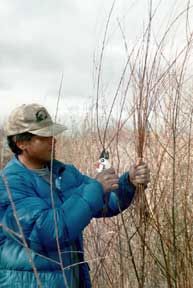
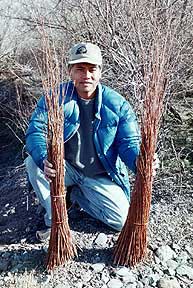
After gathering, the willow withes are completely dried, stored
and then reconstituted later for use. This creates a finished
twined basket that is stiffer and tighter. To reconstitute willow,
the withes are completely submerged in a container of water. Flat
stones are used to keep the withes from floating to the surface.
After the willow becomes flexible, the material is woven into
a utilitarian basket.
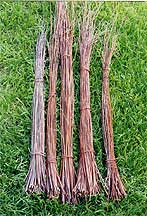
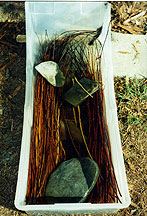
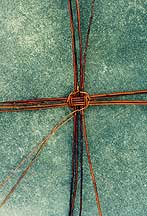
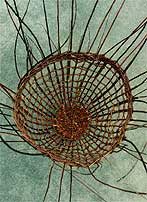
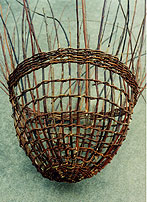
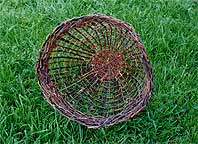
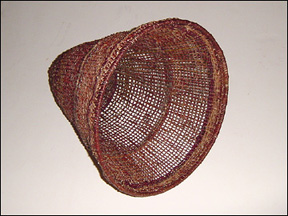
State Parks, wildlife preserves and National Parks have laws
prohibiting the cutting and gathering of wild plants. Know the
laws in your area before attempting to practice any skill. Also,
get permission from the landowner before coppicing wild plants
on private property. Be responsible to the environment and to
the plant. Learning about coppicing skills involves knowing about
the growing cycle of the plant and ensuring that the plant will
continue to propagate. A quote from a Coast Miwok/Kashaya
Pomo basket weaver: "Utilize nature's bounties wisely
by not taking more than what is needed and by not wasting what
is taken."

This article was first published in The
Bulletin of Primitive Technology (Spring 2006, #31)
E-mail your comments to "Dino Labiste" at KahikoArts@yahoo.com
PrimitiveWays
Home Page
We hope the information on the PrimitiveWays website is both instructional and enjoyable. Understand that no warranty or guarantee is included. We expect adults to act responsibly and children to be supervised by a responsible adult. If you use the information on this site to create your own projects or if you try techniques described on PrimitiveWays, behave in accordance with applicable laws, and think about the sustainability of natural resources. Using tools or techniques described on PrimitiveWays can be dangerous with exposure to heavy, sharp or pointed objects, fire, stone tools and hazards present in outdoor settings. Without proper care and caution, or if done incorrectly, there is a risk of property damage, personal injury or even death. So, be advised: Anyone using any information provided on the PrimitiveWays website assumes responsibility for using proper care and caution to protect property, the life, health and safety of himself or herself and all others. He or she expressly assumes all risk of harm or damage to all persons or property proximately caused by the use of this information.
© PrimitiveWays 2016
 Coppicing is based
on the principles of plant physiology. In order to prune effectively,
a weaver has to know something about how a plant grows. A plant
has three main structures: roots, stem and leaves. The roots main
functions are to absorb water and nutrients, to anchor the plant
in the soil and to store food, which is released when required
by root cells or distributed to above ground parts. The stem supports
other plant parts, such as leaves and flowers. It also transports
materials and stores certain materials. The leaves main function
is photosynthesis. Photosynthesis converts energy from the sun
to chemical energy. It is then synthesized to glucose and other
organic compounds necessary for the plant's nutrition.
Coppicing is based
on the principles of plant physiology. In order to prune effectively,
a weaver has to know something about how a plant grows. A plant
has three main structures: roots, stem and leaves. The roots main
functions are to absorb water and nutrients, to anchor the plant
in the soil and to store food, which is released when required
by root cells or distributed to above ground parts. The stem supports
other plant parts, such as leaves and flowers. It also transports
materials and stores certain materials. The leaves main function
is photosynthesis. Photosynthesis converts energy from the sun
to chemical energy. It is then synthesized to glucose and other
organic compounds necessary for the plant's nutrition. is
Sandbar willow (Salix exigua). This hardy plant has perhaps
the greatest range of all tree willows in the United States. It
is found throughout the interior from the Yukon River in central
Alaska to the Mississippi River in southern Louisiana. The leaves
are very narrow and pointed at the ends. The colors of the leaves
are gray-green on both surfaces. Sandbar willow grows in wet soils,
especially riverbanks, sandbars and silt flats.
is
Sandbar willow (Salix exigua). This hardy plant has perhaps
the greatest range of all tree willows in the United States. It
is found throughout the interior from the Yukon River in central
Alaska to the Mississippi River in southern Louisiana. The leaves
are very narrow and pointed at the ends. The colors of the leaves
are gray-green on both surfaces. Sandbar willow grows in wet soils,
especially riverbanks, sandbars and silt flats. Besides creating rapid
regrowth from the edge of the stumps and removing poor specimens,
coppicing Hinds willow has other benefits to the environment.
It increases the amount of light on the ground allowing some flora
to flourish, which in turn supports more diverse wildlife. Also
any diseased growth is cut away before it can spread throughout
the whole tree. For the best willow withes, the plant is coppiced
severely during its dormant period to promote fast growing, straight
shoots for the following year.
Besides creating rapid
regrowth from the edge of the stumps and removing poor specimens,
coppicing Hinds willow has other benefits to the environment.
It increases the amount of light on the ground allowing some flora
to flourish, which in turn supports more diverse wildlife. Also
any diseased growth is cut away before it can spread throughout
the whole tree. For the best willow withes, the plant is coppiced
severely during its dormant period to promote fast growing, straight
shoots for the following year.











